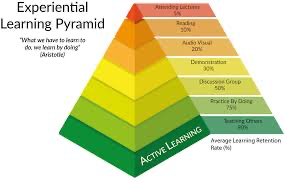Experiential Learning
Experiential learning is the process of learning through experience, and is more specifically defined as "learning through reflection on doing". It is a very effective strategy to create sustainable and inclusive learning experiences.
Process/Implementation
The following text is an adapted version of the wikipedia entry on experiential learning.
Source: Kolb’s learning style and experiential learning cycle
“Learning is the process whereby knowledge is created through the transformation of experience”
- Kolb
Experiential learning entails a hands-on approach to learning that moves away from just the teacher at the front of the room imparting and transferring their knowledge to students. It makes learning an experience that moves beyond the classroom and strives to bring a more involved and sustainable way of learning.
Experiential learning requires self-initiative, an "intention to learn" and an "active phase of learning". Kolb's cycle of experiential learning can be used as a framework for considering the different stages involved, which are::
Concrete experience (do) is when the learner actively experiences an activity such as a lab session or field work.
Reflective observation (observe) is when the learner consciously reflects back on that experience.
Abstract conceptualization (think) is where the learner attempts to conceptualize a theory or model of what is observed.
Active experimentation (plan) is where the learner is trying to plan how to test a model or theory or plan for a forthcoming experience.
Jennifer A. Moon has elaborated on this cycle to argue that experiential learning is most effective when it involves: 1) a "reflective learning phase" 2) a phase of learning resulting from the actions inherent to experiential learning, and 3) "a further phase of learning from feedback". This process of learning can result in "changes in judgment, feeling or skills" for the individual and can provide direction for the "making of judgments as a guide to choice and action". Different learning techniques can be applied in order to create an inclusive and sustainable learning environment. Such elements include practical (doing), emotional (heart), mental (cognitive), spiritual (purpose) components. Combining different methods of learning promotes whole body learning which diversifies the levels of knowing and creates links to previously unknown or implicit sources of knowledge and wisdom.
In order to make learning personal and tangible, reflection or debriefing is a crucial part of the experiential learning process, and like experiential learning itself, it can be facilitated or independent. Dewey wrote that "successive portions of reflective thought grow out of one another and support one another", creating a scaffold for further learning, and allowing for further experiences and reflection. This reinforces the fact that experiential learning and reflective learning are iterative processes, and the learning builds and develops with further reflection and experience. Creating a strong learning container within a group of learners can further incentivize the development of new perspectives and learning experiences. Facilitation of experiential learning and reflection is challenging, but “a skilled facilitator, asking the right questions and guiding reflective conversation before, during, and after an experience, can help open a gateway to powerful new thinking and learning”.
Needed time & Tools/ Materials
An experience
A reflective space or learning vessel: container
Ideally a (team of) facilitator
Curiosity and courage (sometimes)
Personal experience
Learning is often perceived and designed in a rather old-school way, be it a conference, meeting or at university. The current model is based on knowledge transfer in a very top-down way where the source of knowledge only sits with one or few people. Not only is it utterly boring, more importantly it excludes a wide array of learning styles and learning preferences. In order to develop new approaches to solving our most pressing societal challenges, we need to break the conventional ways of how knowledge is transferred and tap into more holistic alternatives. Experiential learning is one of such alternatives. This way, we make learning more diverse, inclusive and interactive, which allows for more innovative and sustainable solutions to emerge.
Experiential learning can be used and applied in basically any setting. It requires an intentional design and a reflection space.
Sources and Further literature
Severin von Hünerbein is in charge of the design and facilitation of collaboratio helvetica’s Catalyst Lab, a learning and design process created to support the implementation of the Sustainable Development Goals (SDGs) in Switzerland. He started his career in training and facilitation with euforia 2010. After graduating from the University of St. Gallen (HSG), he has been determined to bring social innovation to the business world through creating brave spaces that allow a diverse group of people who would usually not meet to find new forms of collaboration, dream together and to co-create innovative and sustainable solutions for systemic change.
He is decorated with a MA degree in International Affairs and with a mind full of jokes, joie-de-vivre, and patience.



